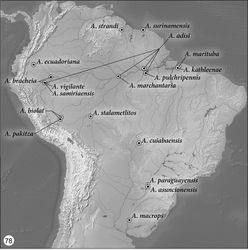Asklepia kathleenae
| Notice: | This page is derived from the original publication listed below, whose author(s) should always be credited. Further contributors may edit and improve the content of this page and, consequently, need to be credited as well (see page history). Any assessment of factual correctness requires a careful review of the original article as well as of subsequent contributions.
If you are uncertain whether your planned contribution is correct or not, we suggest that you use the associated discussion page instead of editing the page directly. This page should be cited as follows (rationale):
Citation formats to copy and paste
BibTeX: @article{Erwin2014ZooKeys430, RIS/ Endnote: TY - JOUR Wikipedia/ Citizendium: <ref name="Erwin2014ZooKeys430">{{Citation See also the citation download page at the journal. |
Ordo: Coleoptera
Familia: Carabidae
Genus: Asklepia
Name
Asklepia kathleenae Erwin & Zamorano sp. n. – Wikispecies link – ZooBank link – Pensoft Profile
Holotype
Brazil, Pará, Belém, 5m, 1.46°S, 48.42°W, 5-8 October 1978 (G.E Ball, K.E. Ball)(NMNH: ADP132460, male).
Derivation of specific epithet
The specific epithet, kathleenae, is an eponym, feminine singular, genitive case, based on the given name of Kathleen E. Ball, who along with her husband, George E. Ball, collected the holotype.
Proposed english vernacular name
Kathleen’s pattern-wing beetle.
Diagnosis
With the attributes of the genus Asklepia as described by Liebke (1938)[1] and as noted above under the generic diagnosis, and small-sized for the genus (SBL = 2.167 mm). Adults with head brunneus, prothorax testaceous, elytral maculae testaceous; elytron brunneus with a small triangular macula in the basal proximal quadrant, an arc-shaped, horizontally oriented macula crossing medial lateral and proximal quadrants, sutural area of apical quadrant testaceous; metasternum, abdominal sterna III-VI, and epipleuron flavotestaceous, abdominal sternum VII slightly infuscated; legs testaceous; antennal scape and pedicel testaceous, antennomeres 3-6 deeply infuscated, 7-11 white. Dorsal surface devoid of microsculpture, surface luster very shiny. Pronotum markedly convex with lateral margin effaced except just anterior to hind angle and there a simple bead; hind angle acute, slightly prominent; median line feebly defined. Elytral interneurs evident as continuous rows of widely spaced coarse punctures.
Description
(Figs 44, 69). Habitus: (Fig. 44). Size: [See also Table 16] Medium-size for the genus; ABL = 2.428 mm, SBL = 2.167 mm, TW (total width) 1.241 mm, LP = 0.484 mm, WP = 0.569 mm, LE = 1.341 mm. Color: See diagnosis above. Luster: See diagnosis above. Head (Fig. 44): as in description for genus above. Prothorax. Pronotum (Fig. 44) slightly broad, narrower than head across eyes (WH/WP: 1.135), longer than head (LP/LH: 1.414), longer than wide (WP/LP: 1.176); surface markedly cordiform, lateral margin effaced with seta at anterior third on slightly raised area; base markedly constricted; anterior angle feebly produced, hind angle slightly produced and setose, median line feebly defined, apical transverse impression punctate, punctures infuscated; smooth throughout. Pterothorax. Normal for genus, see description for genus above. Elytra slightly convex; twice as wide as head across eyes (WH/TW: 0.520) and pronotum (WP/TW: 0.459), longer than wide. Elytral interneurs evident as continuous rows of widely spaced coarse punctures; punctures infuscated; elytron substantially transparent. Hind wings fully developed. Legs. Overall, normal for genus, see description for genus above. Abdominal sterna. Overall, normal for genus, see description for genus above. Male genitalia (Fig. 69, see Fig. 61 for attribute labels). Median lobe with phallobase moderately long about a fourth the length of shaft, basal opening moderately large, oriented parallel to shaft at apical third. Shaft moderately broad, abruptly curved ventrally, dorsally sclerotized except for short ostium; in ventral aspect tapered toward rather narrowly acute apex, in lateral aspect, a moderately broad rounded apex. Parameres: left very large and broad, right small and triangular; apex of left paramere lobate much longer than right paramere about two-thirds the length of shaft (measured in left lateral aspect). Endophallus with 2 preapical spines. Female genitalia. Not investigated, presumably similar to that of Asklepia demiti sp. n.
Dispersal potential
These beetles are macropterous and probably capable of flight. They are moderately swift and agile runners.
Distribution
(Fig. 78). This species has been found at two nearby locations in open grassy swamps along the shore of the lower Río Amazonas. But that does not at all indicate its real distribution: as has been pointed out above, very small beetles are inadequately sampled, especially in the Neotropics.
Way of life
See Erwin (1991)[2] for a general description of the genus. Adults of this species are active in the transition from wet to dry seasons and occur in open grassy marshes.
Other specimens examined
Brazil, Pará, Belém, 5m, 1.46°S, 48.42°W, 5–8 October 1978 (G.E Ball, K.E. Ball)(NMNH: ADP132529, male paratype).
Original Description
- Erwin, T; Zamorano, L; 2014: A synopsis of the tribe Lachnophorini, with a new genus of Neotropical distribution and a revision of the Neotropical genus Asklepia Liebke, 1938 (Insecta, Coleoptera, Carabidae) ZooKeys, 430: 1-108. doi
Images
|



